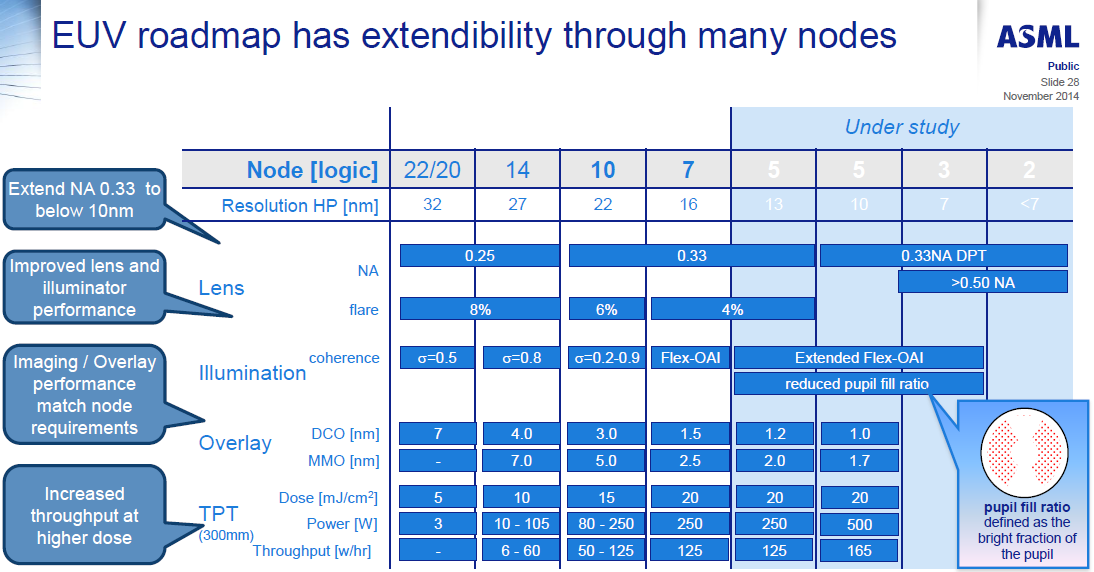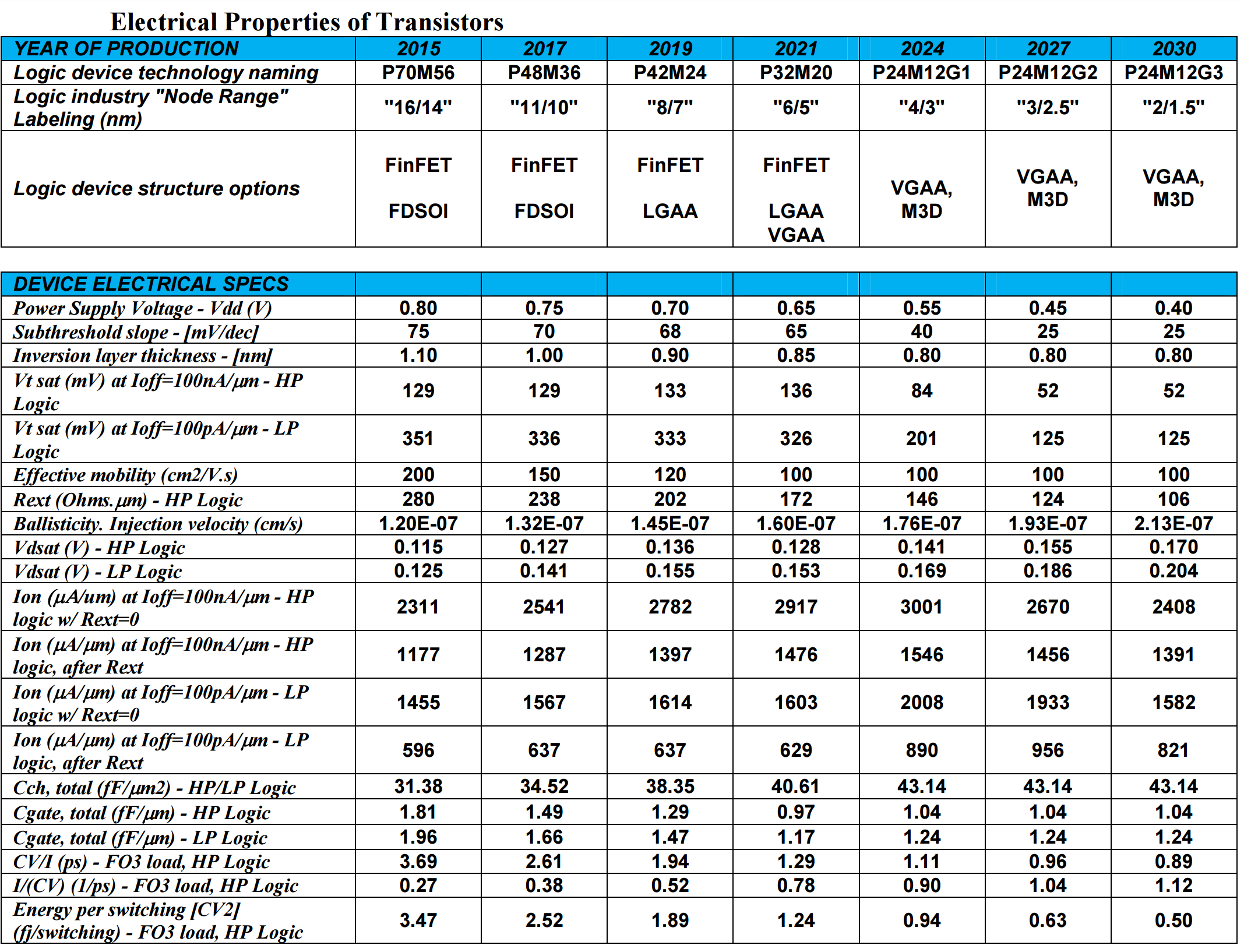Ten Year Anniversary of Core 2 Duo and Conroe: Moore’s Law is Dead, Long Live Moore’s Law
by Ian Cutress on July 27, 2016 10:30 AM EST- Posted in
- CPUs
- Intel
- Core 2 Duo
- Conroe
- ITRS
- Nostalgia
- Time To Upgrade
Looking To The Future: 450mm Wafers in 2021, and Down to ‘2nm’
Most users following the industry will know that the name of the lithographic node, such as ‘14nm’, ‘16nm’ or ‘28nm’ is often an imperfect characterization of what is actually happening on the silicon. For example, Intel’s 14nm node is widely touted as the best in the industry, and the equivalent 14nm/16nm nodes are said to not be even close, due to Intel’s focus on several generations of FinFET compared to the other main semiconductor manufacturers. This also means that while ‘14nm’ or ‘16nm’ is mentioned, many other parts of the silicon could be manufactured on other nodes, depending on the utility.
We’ve spoken in the past about equipment roadmaps to deal with the problem of shrinking lithography node sizes. This includes new lasers, droplet generation, collectors, masks, defect detection, lenses, and the technology to drive high throughput. For example, here are ASML’s EUV requirements for the next few manufacturing nodes, including requirements for 250W light sources at a 5nm node:
With the ITRS report, it makes a couple of metrics regarding node sizes and wafers. On the later, we get the prediction that 450mm wafers should be in play at around 2021 for DRAM:
This matches at DRAM half-pitch of 15nm, or a DRAM cell size of 780nm2, compared to 3480nm2 today. The movement to 450mm wafers has been expected for some time, with early predictions going for the 2008-2011 timeframe, however development seems to have stalled for a variety of reasons.
When it comes to transistors, given the node naming scheme caveats listed above, the ITRS report predicts that FinFET will make way at around the 2021 timeframe in favor of 3D stacking such as ‘vertical gate all-around’ (VGAA). As the node shrinks, as well as the transistor size, the power supply voltage will drop from 800mV today down to 400/450mV by 2027.
Moving into a world of IoT will require even lower power transistors, of which moving to a ‘smaller node’ and vertical chip integration will be a large part.
The ITRS report goes into a lot of detail regarding different stacking technologies, such as the 2.5D integration we see on products like AMD’s Fiji GPU involving a silicon interposer, as well as 3D and the different ways to implement both microchannel cooling in such chips as well as 3D TSV applications.













158 Comments
View All Comments
Namisecond - Thursday, July 28, 2016 - link
NVMe may not be all it's cracked up to be. It, for the most part, limits you to booting windows 8 and higher, and good luck with the free upgrade to windows 10 (which supposedly ends tomorrow).FourEyedGeek - Monday, August 8, 2016 - link
Same CPU here, mine is running at 4Ghz, I can't see a reason other than NVMe to upgrade.dotwayne - Thursday, July 28, 2016 - link
Had a trusty E6300 @ 3.4-5 ghz back then. ahhh...miss those days of oc-ing the shit out of these cheap but super capable silicons.jamyryals - Thursday, July 28, 2016 - link
Neat article, I enjoyed it Ian!azazel1024 - Thursday, July 28, 2016 - link
Yeah a lot of those assumptions and guestimates for the future seem either overly optimistic or seem to ignore realities. I realize board power doesn't equate to average power use, but you are still talking about max power consumption that would drain a current cell phone battery dead in less than an hour, even on some of the biggest phone batteries.Beyond that is the heat dissipation, that phone is going to get mighty hot trying to dissipate 8+ watts out of even a large phone chassis.
As pointed out, 32 cores seems a wee excessive. A lot of it seems to be "if we take it to the logical extreme" as opposed to "what we think is likely".
Peichen - Thursday, July 28, 2016 - link
Take a 45nm C2Q Q9650 ($50 eBay), overclock to 4.0GHz, and you will be as fast as AMD's FX-9590 that's running at 220W. Older motherboard and DDR2 will be harder to come by but it is sad how AMD never managed to catch up to Core 2 after all these years. E6400 was my first Intel after switching to AMD after the original Pentium and I have never look back at AMD again.Panoramix0903 - Thursday, July 28, 2016 - link
I have made an upgrade from C2D 6550 to Q9650 in my old DELL Optiplex 755 MT. Plus 4x 2GB DDR2 800 MHz, Intel 535 SSD 240 GB, Sapphire Radeon HD7750 1GB DDR5, Sound Blaster X-FI, and USB 3.0 PCI-E card. Running Windows 7 Professional. 3-times more power then original DELL configuration :-)JohnRO - Thursday, July 28, 2016 - link
I just logged in to tell you that I'm reading this article on my desktop PC which has a Intel Core 2 Duo E4300 processor (1,8 GHz, 200 MHz FSB) with 4 GB of RAM (started with 2). When I wanted (or needed) I overclocked this processor to 3 GHz (333 MHz FSB).My PC will have its 10 years anniversary this December. During the years I upgraded the video card (for 1080p h264 hardware decoding and games when I still played them) and added more hard drives. The PC has enough performance for what I’m using it right now – so I would say that this is a good processor.
siriq - Thursday, July 28, 2016 - link
I still got my mobile 2600+ barton @2750 mhz , 939 3800+ x2 @2950 mhz . They were awesome!althaz - Thursday, July 28, 2016 - link
I bought a C2D E6300 the week it came out, my first Intel CPU since 2000. My previous CPUs had been an AMD Athlon 64 and an AMD Athlon Thunderbird.That E6300 remains my all-time favourite CPU. It's still running in a friend of mine's PC (@ 2.77Ghz, which I overclocked it to soon after getting it). It was just *so* fast compared to my old PC. Everything just instantly got faster (and I hadn't even upgraded my GPU!).